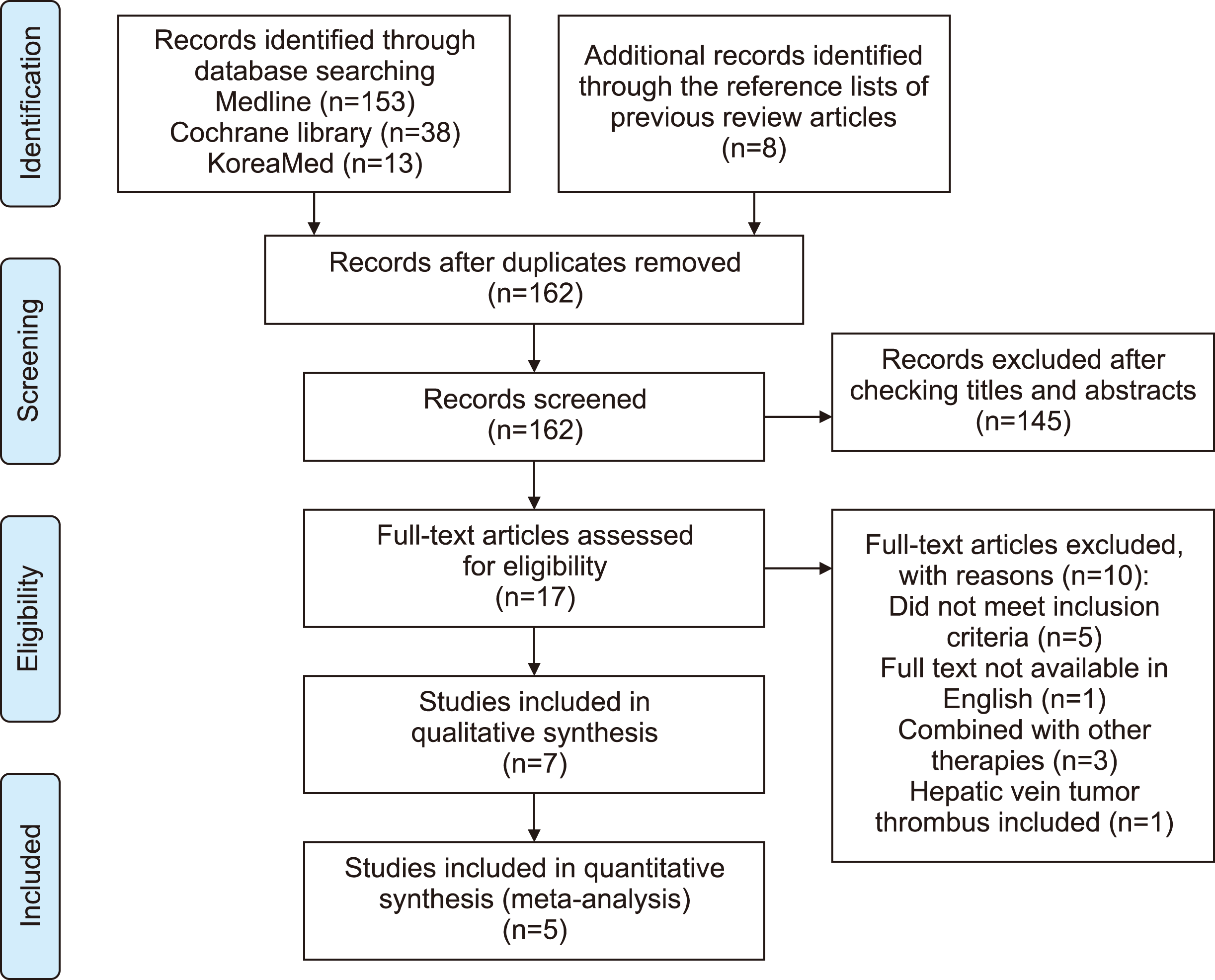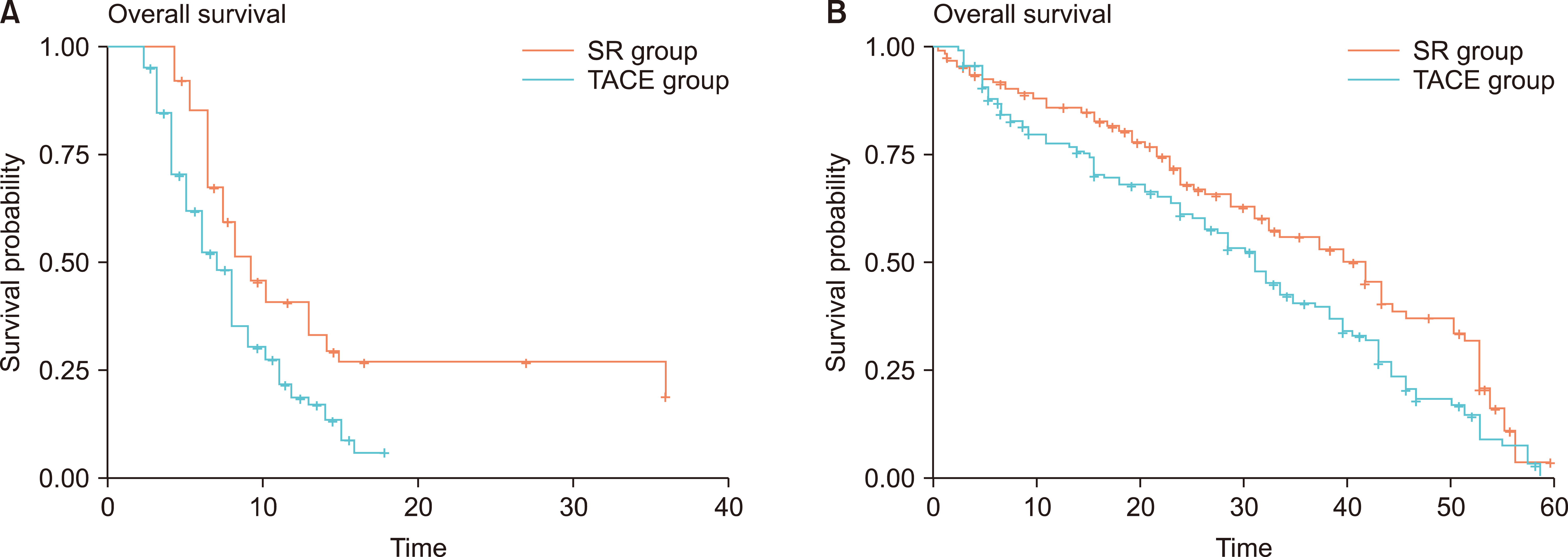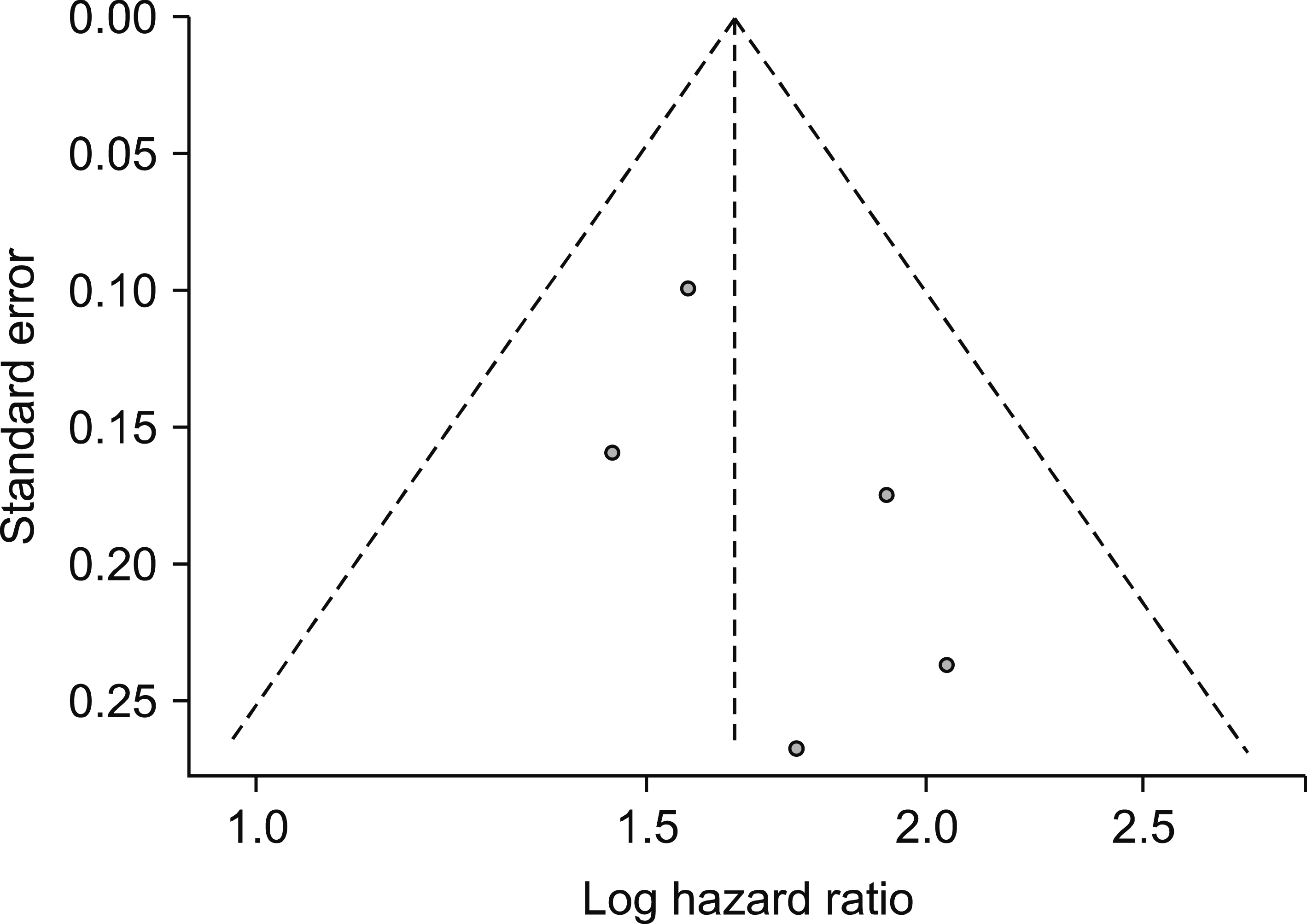2. Tunissiolli NM, Castanhole-Nunes MMU, Biselli-Chicote PM, Pavarino EC, da Silva RF, da Silva RC, et al. 2017; Hepatocellular carcinoma: a comprehensive review of biomarkers, clinical aspects, and therapy. Asian Pac J Cancer Prev. 18:863–872. DOI:
10.22034/APJCP.2017.18.4.863. PMID:
28545181. PMCID:
PMC5494234.
3. Llovet JM, Ricci S, Mazzaferro V, Hilgard P, Gane E, Blanc JF, et al. 2008; Sorafenib in advanced hepatocellular carcinoma. N Engl J Med. 359:378–390. DOI:
10.1056/NEJMoa0708857. PMID:
18650514.

4. Cheng AL, Kang YK, Chen Z, Tsao CJ, Qin S, Kim JS, et al. 2009; Efficacy and safety of sorafenib in patients in the Asia-Pacific region with advanced hepatocellular carcinoma: a phase III randomised, double-blind, placebo-controlled trial. Lancet Oncol. 10:25–34. DOI:
10.1016/S1470-2045(08)70285-7. PMID:
19095497.

5. Cerrito L, Annicchiarico BE, Iezzi R, Gasbarrini A, Pompili M, Ponziani FR. 2019; Treatment of hepatocellular carcinoma in patients with portal vein tumor thrombosis: beyond the known frontiers. World J Gastroenterol. 25:4360–4382. DOI:
10.3748/wjg.v25.i31.4360. PMID:
31496618. PMCID:
PMC6710186.

6. Minagawa M, Makuuchi M. 2006; Treatment of hepatocellular carcinoma accompanied by portal vein tumor thrombus. World J Gastroenterol. 12:7561–7567. DOI:
10.3748/wjg.v12.i47.7561. PMID:
17171782. PMCID:
PMC4088035.

7. Llovet JM, Bustamante J, Castells A, Vilana R, Ayuso Mdel C, Sala M, et al. 1999; Natural history of untreated nonsurgical hepatocellular carcinoma: rationale for the design and evaluation of therapeutic trials. Hepatology. 29:62–67. DOI:
10.1002/hep.510290145. PMID:
9862851.

8. Manzano-Robleda Mdel C, Barranco-Fragoso B, Uribe M, Méndez-Sánchez N. 2015; Portal vein thrombosis: what is new? Ann Hepatol. 14:20–27. DOI:
10.1016/S1665-2681(19)30797-5. PMID:
25536638.
9. Suh SJ, Yim HJ, Lee DW, Hyun JJ, Jung YK, Kim JH, et al. 2017; Factors affecting prognosis of hepatocellular carcinoma with portal vein tumor thrombosis: implications for future therapeutic strategies. J Liver Cancer. 17:60–71. DOI:
10.17998/jlc.17.1.60.
10. Jarnagin W, Chapman WC, Curley S, D'Angelica M, Rosen C, Dixon E, et al. 2010; Surgical treatment of hepatocellular carcinoma: expert consensus statement. HPB (Oxford). 12:302–310. DOI:
10.1111/j.1477-2574.2010.00182.x. PMID:
20590903. PMCID:
PMC2951816.

11. Kudo M, Izumi N, Kokudo N, Matsui O, Sakamoto M, Nakashima O, et al. 2011; Management of hepatocellular carcinoma in Japan: Consensus-Based Clinical Practice Guidelines proposed by the Japan Society of Hepatology (JSH) 2010 updated version. Dig Dis. 29:339–364. DOI:
10.1159/000327577. PMID:
21829027.

12. Zheng N, Wei X, Zhang D, Chai W, Che M, Wang J, et al. 2016; Hepatic resection or transarterial chemoembolization for hepatocellular carcinoma with portal vein tumor thrombus. Medicine (Baltimore). 95:e3959. DOI:
10.1097/MD.0000000000003959. PMID:
27367992. PMCID:
PMC4937906.

13. Shi J, Lai EC, Li N, Guo WX, Xue J, Lau WY, et al. 2010; Surgical treatment of hepatocellular carcinoma with portal vein tumor thrombus. Ann Surg Oncol. 17:2073–2080. DOI:
10.1245/s10434-010-0940-4. PMID:
20131013.

14. Liu L, Zhang C, Zhao Y, Qi X, Chen H, Bai W, et al. 2014; Transarterial chemoembolization for the treatment of advanced hepatocellular carcinoma with portal vein tumor thrombosis: prognostic factors in a single-center study of 188 patients. Biomed Res Int. 2014:194278. DOI:
10.1155/2014/194278. PMID:
24800212. PMCID:
PMC3996986.

15. Silva JP, Berger NG, Tsai S, Christians KK, Clarke CN, Mogal H, et al. 2017; Transarterial chemoembolization in hepatocellular carcinoma with portal vein tumor thrombosis: a systematic review and meta-analysis. HPB (Oxford). 19:659–666. DOI:
10.1016/j.hpb.2017.04.016. PMID:
28552299.

16. Zhang XP, Wang K, Li N, Zhong CQ, Wei XB, Cheng YQ, et al. 2017; Survival benefit of hepatic resection versus transarterial chemoembolization for hepatocellular carcinoma with portal vein tumor thrombus: a systematic review and meta-analysis. BMC Cancer. 17:902. DOI:
10.1186/s12885-017-3895-z. PMID:
29282010. PMCID:
PMC5746018.

17. Zhang ZY, Dong KS, Zhang EL, Zhang LW, Chen XP, Dong HH. 2019; Resection might be a meaningful choice for hepatocellular carcinoma with portal vein thrombosis: a systematic review and meta-analysis. Medicine (Baltimore). 98:e18362. DOI:
10.1097/MD.0000000000018362. PMID:
31852141. PMCID:
PMC6922393.
18. Batson S, Greenall G, Hudson P. 2016; Review of the reporting of survival analyses within randomised controlled trials and the implications for meta-analysis. PLoS One. 11:e0154870. DOI:
10.1371/journal.pone.0154870. PMID:
27149107. PMCID:
PMC4858202.

19. Guyot P, Ades AE, Ouwens MJ, Welton NJ. 2012; Enhanced secondary analysis of survival data: reconstructing the data from published Kaplan-Meier survival curves. BMC Med Res Methodol. 12:9. DOI:
10.1186/1471-2288-12-9. PMID:
22297116. PMCID:
PMC3313891.

20. R Development Core Team. 2017. R: a language and environment for statistical computing. R Foundation for Statistical Computing;Vienna: Available from:
https://www.R-project.org/.
22. Fan J, Zhou J, Wu ZQ, Qiu SJ, Wang XY, Shi YH, et al. 2005; Efficacy of different treatment strategies for hepatocellular carcinoma with portal vein tumor thrombosis. World J Gastroenterol. 11:1215–1219. DOI:
10.3748/wjg.v11.i8.1215. PMID:
15754408. PMCID:
PMC4250717.

23. Peng ZW, Guo RP, Zhang YJ, Lin XJ, Chen MS, Lau WY. 2012; Hepatic resection versus transcatheter arterial chemoembolization for the treatment of hepatocellular carcinoma with portal vein tumor thrombus. Cancer. 118:4725–4736. DOI:
10.1002/cncr.26561. PMID:
22359112.

24. Liu PH, Lee YH, Hsia CY, Hsu CY, Huang YH, Chiou YY, et al. 2014; Surgical resection versus transarterial chemoembolization for hepatocellular carcinoma with portal vein tumor thrombosis: a propensity score analysis. Ann Surg Oncol. 21:1825–1833. DOI:
10.1245/s10434-014-3510-3. PMID:
24499831.

25. Ye JZ, Zhang YQ, Ye HH, Bai T, Ma L, Xiang BD, et al. 2014; Appropriate treatment strategies improve survival of hepatocellular carcinoma patients with portal vein tumor thrombus. World J Gastroenterol. 20:17141–17147. DOI:
10.3748/wjg.v20.i45.17141. PMID:
25493028. PMCID:
PMC4258584.

26. Lee JM, Jang BK, Lee YJ, Choi WY, Choi SM, Chung WJ, et al. 2016; Survival outcomes of hepatic resection compared with transarterial chemoembolization or sorafenib for hepatocellular carcinoma with portal vein tumor thrombosis. Clin Mol Hepatol. 22:160–167. DOI:
10.3350/cmh.2016.22.1.160. PMID:
27044767. PMCID:
PMC4825165.

27. Wang K, Guo WX, Chen MS, Mao YL, Sun BC, Shi J, et al. 2016; Multimodality treatment for hepatocellular carcinoma with portal vein tumor thrombus: a large-scale, multicenter, propensity mathching score analysis. Medicine (Baltimore). 95:e3015. DOI:
10.1097/MD.0000000000003015. PMID:
26986115. PMCID:
PMC4839896.
30. Tanaka A, Morimoto T, Yamaoka Y. 1996; Implications of surgical treatment for advanced hepatocellular carcinoma with tumor thrombi in the portal vein. Hepatogastroenterology. 43:637–643. PMID:
8799408.
31. Chok KS, Cheung TT, Chan SC, Poon RT, Fan ST, Lo CM. 2014; Surgical outcomes in hepatocellular carcinoma patients with portal vein tumor thrombosis. World J Surg. 38:490–496. DOI:
10.1007/s00268-013-2290-4. PMID:
24132826.

32. Wu CC, Hsieh SR, Chen JT, Ho WL, Lin MC, Yeh DC, et al. 2000; An appraisal of liver and portal vein resection for hepatocellular carcinoma with tumor thrombi extending to portal bifurcation. Arch Surg. 135:1273–1279. DOI:
10.1001/archsurg.135.11.1273. PMID:
11074879.

34. Cheng AL, Guan Z, Chen Z, Tsao CJ, Qin S, Kim JS, et al. 2012; Efficacy and safety of sorafenib in patients with advanced hepatocellular carcinoma according to baseline status: subset analyses of the phase III Sorafenib Asia-Pacific trial. Eur J Cancer. 48:1452–1465. DOI:
10.1016/j.ejca.2011.12.006. PMID:
22240282.

35. Kudo M. 2011; Signaling pathway and molecular-targeted therapy for hepatocellular carcinoma. Dig Dis. 29:289–302. DOI:
10.1159/000327562. PMID:
21829020.

36. Wilhelm SM, Adnane L, Newell P, Villanueva A, Llovet JM, Lynch M. 2008; Preclinical overview of sorafenib, a multikinase inhibitor that targets both Raf and VEGF and PDGF receptor tyrosine kinase signaling. Mol Cancer Ther. 7:3129–3140. DOI:
10.1158/1535-7163.MCT-08-0013. PMID:
18852116.

37. Mazzaferro V, Sposito C, Bhoori S, Romito R, Chiesa C, Morosi C, et al. 2013; Yttrium-90 radioembolization for intermediate-advanced hepatocellular carcinoma: a phase 2 study. Hepatology. 57:1826–1837. DOI:
10.1002/hep.26014. PMID:
22911442.

38. Kim DY, Park BJ, Kim YH, Han KH, Cho SB, Cho KR, et al. 2015; Radioembolization with yttrium-90 resin microspheres in hepatocellular carcinoma: a multicenter prospective study. Am J Clin Oncol. 38:495–501. DOI:
10.1097/COC.0b013e3182a78dba. PMID:
24064753.




 PDF
PDF Citation
Citation Print
Print







 XML Download
XML Download